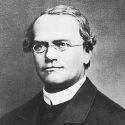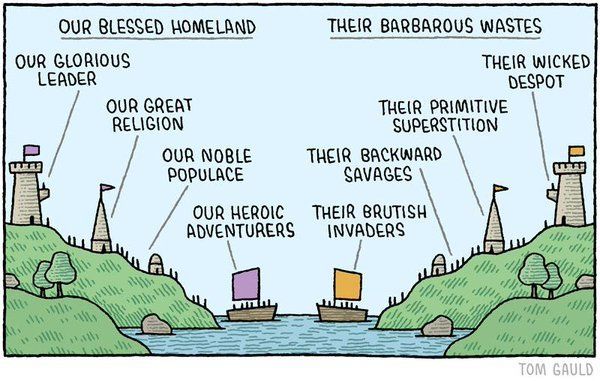Stoanova
This presentation of Stoanova is a response to the rapidly growing shrillness and polarization of public discourse. Social media tends to encourage the formation of echo chambers where people of like mind gather and reinforce a particular world view and set of assumptions, treating as a pariah anyone who brings information from outside of the group’s approved sources. Accompanying the echo chamber phenomenon is a startling absence of thought.
Thankfully, not everyone is caught up in the trend toward thoughtless stridency. Plenty of people consider issues in a calmer and more reasoned fashion.
But while the echo chambers have their emotion-laden rallying cries, thinkers, by their nature, tend not to. A flag that shouts “Don’t Tread On Me!” is a lot more effective in rounding up true believers than one emblazoned with “Hmm, Let’s Think About This...”
That’s a problem. Outside of social media, and before it, there are and were all sorts of organizations where calm and thoughtful people gather to discuss things in a calm and thoughtful fashion. Their existence has provided an important space where valuable ideas and policies and initiatives are born.
And so, Stoanova is about a better kind of social media, a space governed by civility and by something called the engineering mindset, which will be described later as the last of our “Items.”
Is Stoanova right for you?
Let’s find out.
Item 1: Whaddya Know
There is a distinct social trend of disaffection with religion
The trend begs the question: is religion good or bad?
Whatever the answer, one thing is certain: the scriptures underlying of all the major religions were written long before people knew anything about DNA, subatomic particles, PKI, endocrinology, microbes, the immune system, electromagnetic radiation, digital signatures, relativity, quantum phenomena – or even electricity. Offsetting the deep wisdom of antiquity’s best thinkers was profound ignorance of the world around and within them.
Stoanova is a retrofit, an update, to religion.
Any religion.
Including “Atheism”.
(For the explanation of the quotation marks, watch the video below).
Stoanova’s premise is that all religions could benefit from thoughts, observations, and discoveries that appeared in the millennia since their holy scriptures were written.
If you agree that religions could benefit from updates from things that have been learned since their scriptures were written then we hope you’ll be interested in learning more – and in joining us.
Stoanova is monotheistic. This should really be a minor detail, not worthy of top billing, but people make so much of this trivial matter of belief in God.
If you claim to be an atheist then you are welcome to join. Stoanova can serve you well. That’s because despite your claim, you are not an atheist.
To allow us to prove that, watch this short video:
The words “atheist” and “theist” presume that we can know where we came from, that is, that we can figure out how the universe works. That’s nothing new. Human beings have always pursued that conceit.
The first time we figured it out we discovered that at the bottom of it all were the four elements: earth, air, fire and water. Only a few details remained to be worked out.
Then in working out the details, new instruments such as telescopes and microscopes and other instrumentation that showed how incredibly naive we were with those assumptions.
That process repeats itself over and over as our human hubris tells us that this time we’re closing in on the great unifying theory and its proof.
Adam Kirsch, writing recently in the New Yorker, in his Philosophy in the Shadow of Nazism, shows how the members of the Vienna Circle put it all together on a “rigorously logical footing”:
“For Wittgenstein, the renovation of philosophy had to begin with language. Since the Greeks, Western thinkers had tried to understand the world using terms such as “being” and “becoming,” “substance” and “essence,” “real” and “ideal.” But these abstractions gave rise to complicated arguments that went around and around, never reaching any definite conclusion. Now, in the early twentieth century, relativity and quantum theory were redrawing the map of reality in ways that could be verified by experiment and given precise mathematical expression. In an age of triumphant physics, did philosophy still need to bother with metaphysics?
By declaring the answer to be no, Wittgenstein set modern thought on a new course. For the analytic philosophy he helped inspire, many of the discipline’s traditional problems are actually just misunderstandings, based on an erroneous use of language.”
Quantum and relativistic phenomena and other discoveries disrupted everything. But we're far from done with the disruption. Consider the possibility that scale is infinite in both directions: our universe is an atom inside a universe which is an atom inside a universe ad infinitum; and a hydrogen atom contains subatomic particles, each of which contains atom-like structures, inside each of which are atom-like structures, ad infinitum. What about the question of what does it mean to be “before” the Big Bang if time came into existence at the Big Bang?
What if it’s all built on semantics that represent artificial distinctions? Are you really not going to be happy until you as a scientist figure it all out? Good luck wi dat.
With my undergraduate degree in physics, I’ve been taught that the dominant process in the universe is entropy, which tells us that everything is going toward randomness. Then when I went to the Chilean desert I witnessed the total solar eclipse, exactly as predicted, at precisely 20:32 on July 2, 2019. So, the part of existence we inhabit (in one of perhaps an infinite number of universes?), which was formed out of a totally amorphous cloud of particles, has organized itself into a solar system of incredible precision. Sure, the mathematics and physics of the solar system is understandable and explainable. But as a witness to something profoundly anti-entropic, not to mention beautiful in its precision, it would be nothing but foolish hubris to pretend that the whole thing is understandable. It’s great to pursue a unifying theory of everything as long as you understand that you’ll never get there.
Albert Camus, along with many mostly Asian philosophers, have indeed figured “it” out. Because he had hung around with Sartre, Camus chose expressions like “Life is absurd” or “Life is meaningless” but as you read deeper you see that he was saying: “You’ll never figure it all out, so find your happiness where you are.”
Stoanova is based upon the admonition to “Humble thyself”.
“Atheist” and “Theist” are words that presume that you’ve figured it out.
But you haven’t.
Let it go.
Item 2: Belief
Religion asks us to believe things which we’re inclined not to believe. It calls for belief in claims that our increasingly empirical minds have difficulty believing.
And yet, in 1637 René Descartes, the empiricist to beat all empiricists, showed that everything is built upon faith. Everything, that is, except the knowledge that some one thing exists because that something must be doing the thinking about whether anything exists. Other than that one bit of knowledge, everything we think we know depends upon our senses, which may not only deceive us but which may themselves be illusory. Therefore everything taken in by our senses – i.e. everything –is accepted purely on faith.
Making matters even more interesting: a few hundred years after Descartes, scientific discoveries such as general relativity and quantum mechanics ask us to accept things that are more nonsensical than anything in religious scripture.
So does that make more believable those unbelievable things that religion asks us to take on faith?
Here you’re on your own. Your empirical mind will be of no help; nor will Stoanova. It’s purely for you to decide what you accept on the basis of faith, guided by whatever works for you.
It’s also for you not to decide. Was water really instantly turned to wine? Who knows, none of us was around 2000 years ago to witness the event and write the tasting notes. I for one am perfectly content being clueless about whether that, or any other miraculous event described in scripture, actually happened.
Sometimes people conflate belief with faith. In Stoanova, belief is not important – but a willingness and ability to suspend belief is.
Item 3: Leadership
The ideas in Stoanova are mostly not new. So the news here isn’t the ideas. The news is that we are catalyzing people of like mind to form a community of values in the same way religions have done successfully for millennia.
Almost all religions have an elite, a class of priests to whom the masses of believers look not just for interpretation of scripture but for interpretation of the rest of life as well. Throughout most of human history, a large proportion of scientists and philosophers were also clergy or other religious leaders:
Here are just a few:
![Maria Gaetana Agnesi was an Italian mathematician, philosopher,
theologian, and humanitarian. She was the first woman to writea mathematics handbook and the first woman appointed as a
mathematics professor at a universityOriginal image by Unknown (cropped> Public Domain]https://commons.wikimedia.org/w/index.php?curid=372815 Maria Gaetana Agnesi](images/Maria_Gaetana_Agnesi-square-crop.jpg)
Maria Gaetana Agnesi

Johannes Kepler

Jennifer Wiseman

Jose de Acosta

Nicolaus Copernicus

Kathleen Lonsdale

Sir Francis Bacon

Hildegard of Bingen

Athanasius Kirchner

Roger Joseph Boscovich

Katherine Hayhoe

Gregor Mendel

Sister Mary Celine Fasenmyer

William of Ockham

Jocelyn Bell Burnell

Christopher Clavius

Georges Lemaître

Francesco Maria Grimaldi
A Presbyterian minister and mathematician, Thomas Bayes, contributed to the logic of decisions in a way that was similar to the Bernoulli method that we will cite shortly as a test of the engineering mindset.
As literacy became more common, and as the clergy-scientists themselves made discoveries that appeared to contradict their own scripture, the basis for their elite status gradually eroded.
What wasn’t eroded was the need for society to be led by smart, value-driven people who can engage with others in finding solutions to complex problems – while also working to avoid the kind of polarizing shrillness that takes over the public square when such leadership is lacking.
This time around, let’s dispense with the process of selection of members of the elite by the operation of an old, politically-infested, male dominated hierarchy.
Instead, let’s use simple self-selection. If after reading about Stoanova you believe you fit the descriptions and you enjoy engaging with other smart people in a focused and disciplined pursuit of solutions to society’s problems, then consider joining Stoanova.
Item 4: Community
In spite of what I just wrote about belief, I must admit with some sheepishness that on many Sundays I join millions of people around the world, reciting in droning unison the Apostle’s Creed, proclaiming that I know that all the major miraculous events in the Christian Bible actually happened.
I do that for the same reason that I suspect most of my fellow droners do: because we are a community of faith.
Faith in the veracity of claims of miracles?
Nah, not so much.
Faith in shared values?
Yeah, that’s it.
Christians believe in the set of values that their particular Christian denomination professes. Same with other religious communities.
Regardless of how you feel about any particular religious denomination, do you like the idea of communities of shared values? If you do, and if you like the values that Stoanova puts forth, perhaps you’ll consider learning more, and perhaps you’ll join Stoanova.
So members of my denomination proclaim in unison beliefs that certain events actually happened, even though we may individually be undecided about whether they actually did happen.
Hey, we never claimed to be perfect.
Item 5: Humble Thyself
And in fact the need to understand that distance from perfection is a core value of Christianity and other religions and sets of beliefs. Among the latter is stoicism in its many forms, from the ancient to the contemporary. If we’re not careful, we humans are inclined to believe we’re really hot stuff. And the more strongly we believe it, the more we attract a following of people who want to vicariously participate in our grandeur by feeding it with support, praise and adulation. It can really get out of hand, as we have all seen. That drug is addictive.
That is one of the big troubles with us humans. Christ and Freud and plenty of others have warned us of the depravity of big parts of our basic nature. When we tell ourselves that things like the need for humility apply only to other people, that we really belong in the seat just to the right of the throne of perfection, we get into big trouble.
Item five is straight from religious scripture. While there’s a version of it in all monotheistic religions, the Christian version is “Humble thyself in the sight of God and He will lift you up" (James 4: 10,11).
That-Which-Created-You-And-Me is greater than you and me. The more you keep that in mind using whatever works for you – worship, meditation, whatever – the better off you will be, in all ways.
You are fallible. You have shortcomings. The grace of That-Which-Created-You-And-Me is what will give you your next breath, your next heartbeat, your next neurochemical reaction, in spite of the many reasons why you don’t deserve that incredible gift.
Question 1
Here’s a first question to help you decide whether you might be interested in joining Stoanova:
- Count your next sixteen heartbeats.
- Think about what made those heartbeats occur. Aside from maintaining the body that was given to you, did you do anything to make those heartbeats happen; to make them possible?
- Ask yourself how you feel about that which gave you a beating heart. Are you thankful for it?
If you feel thankful for that which gave you a beating heart, you may find Stoanova to be of interest.
If not, you probably won’t.
“That-Which-Created-You-And-Me” is an awkward name, so let’s find a gender-neutral pronoun for it.
How about something short, let’s say three letters, easy to pronounce.
I got it! How about “God.”
It’s even short and pronounceable enough to serve as its own pronoun, with gender neutrality built in.
Humble thyself in the sight of God and He God will lift you up.
Item 6: Local Governance
Faith has repeatedly been corrupted over the centuries in ways that result in persecution, murder and war. Over and over we have seen religious leaders betray the trust that was placed in them.
Religious hierarchies were developed in a time before common literacy, before printing technology, and long before digital networking. In those days you needed priests who would meet with bishops who would meet with archbishops etc. to ensure that those common values were communicated to the illiterate masses.
Then the more ambitious priests would elbow their way up hierarchical ladder using methods that were quite contrary to what they were teaching their flock. So much for those common values. Religious hierarchies tend to corrupt.
Leadership problems aside, religion can provide a good framework for shared values. Often, religious congregations can provide what their own religions have difficulty providing. A member of a congregation tends to see themselves as accountable to other members of the congregation. Accountability is good.
A congregation can be the catalyst for groups of people to help those less fortunate than themselves, when individual initiative would have failed to do that. As we will see, the same technologies that match your need for a ride to the airport with a driver wanting to provide that ride can be applied to matching all sorts of needs with those who can fill the need.
Stoanova has no hierarchies, no bishops, no titled nobility. Leadership of a congregation is by volunteers. Everything in Stoanova is done by volunteers except when there is paid administrative help, which serves at the direction of volunteers. As with the original Congregational Church, the standards and values are established in a document (this document) and shared and reinforced in gatherings of limited size, both face-to-face and online.
Decisions are made in deliberations that are managed by moderators in a process we will describe shortly.
Religious teaching can help an individual understand their relationship to their creator, and curriculum based upon scripture is the essence of that.
Stoanova provides the foundation of a community where people of shared values can reinforce each other regardless of their religious affiliations. Just as important, it provides the information age facilities for acting on those values.
In Stoanova there is no coercion. If someone is not following the standards and values, another member may bring the deficiency to their attention. If it turns out that the alleged transgressor disagrees substantially with Stoanova’s values and standards then they will likely choose not to continue being part of Stoanova. In that case there will be no shunning, no ostracism. Stoanovans should always be on guard against the adoption of the methods used by cults.
Item 7: Accountable Anonymity
In my books and videos I’ve made comparisons between a village of 800 people and a global village of 8 billion people; and attempted to show how PKI, when deployed properly (which has been rare) can provide the kind of mutual accountability in the global village that we have in a traditional small village. (After we’re done here perhaps you’ll read about, or watch the video about, how my daughter got me thinking about how PKI Done Right solves huge numbers of problems.) Watch this video for an explanation of PKI.
Of course accountability in any size village can have its downside. In a village of 750, everyone knows you, your strengths and weaknesses and the indiscretions you really wish they would forget about. But then you know about the indiscretions of others so it all evens out.
With PKI, accountability in a global village of 7.5 billion people is very possible. But unless it’s done right, the downside is much more onerous than accountability in a small village. We no longer need to point to George Orwell’s 1984 as invasion of privacy is just a fact of life these days. And that must be remedied
Accountable Anonymity is the solution.
With Accountable Anonymity, information about you is your own personal intellectual property, protected by both copyright law and secrecy law, as well as by PKI technology. Your personal nondisclosure agreement is something that those who want to know about you must either implicitly agree to or explicitly sign – and they’re still not done because they then need a license from you to use your personal information, and use it only for the purposes spelled out in the license.
Another part of Accountable Anonymity is your license plate credential. It works like your car’s license plate. Your car’s license plate makes you accountable for what happens on public roadways – but no one gets to know the identity of the driver or owner unless there’s been an accident or other incident. In the same way, your license plate credential lets you assert your identity without disclosing your identity.
You can have as many license plate credentials as you want, making it difficult for nosy social media companies and others to track your every move. But if you defraud or defame someone, or you engage in illegal activities online, and someone produces a court order, your identity can be uncovered and disclosed. That’s because your license plate credential is linked to a very private digital birth certificate that contains, or links to, that information. (The court order can come from any court in the world, but that court must pass muster with the courts of the Canton of Geneva, preventing repressive regimes from abusing the system.)
All very well and good, you say, but who’s to say that the information in your digital birth certificate is accurate? Who is to say that you are who you claim to be?
Every PKI must have at least one certification authority, and this PKI, called The Authenticity Infrastructure, is no different. Our certification authority takes the form of a municipality; and if you have one of its credentials then you own the city.
(This has opened a lively debate about the question: who owns the city where you live? Some say a municipality is owned by its residents, while others disagree. Whatever, if you have a digital residence in a community that accepts the governance of this city-in-cyberspace, the City of Osmio, then you own the City of Osmio. Check it out at governance.osmio.ch.)
The City of Osmio Vital Records Department uses what are known in PKI-speak as “registration authorities” to gather EOI – evidence of identity – from various sources. Each of eight forms of EOI is reported with a score of zero to nine, giving an aggregate score of zero to seventy-two. Any relying party gets to know the Identity Quality score of the credential and whether or not it is currently valid – and nothing more. Not the enrolled person’s name, location, age, gender – nothing, unless enrolled person chooses to disclose more about herself.
If the enrolled person wrongs you there is recourse. With a valid court order you will learn their identity. Otherwise all you know is that there is a real person behind the credential who is accountable for what they do.
Item 8: Optimocracy
Now that we have accountability we can have governance. We mentioned in Item 6 that governance meetings are let by moderators.
Moderators are elected using something called “optimocracy.”
Optimocracy is a process that emulates in the digital world a familiar process in the governance of municipalities. Effectively, cities and towns are governed by activists, that is, by people who have the time, interest, focus, and intellectual capability to participate in hearings and other city forums.
In an optimocracy, anyone can join a deliberation and anyone who is measurably active in the online room where the deliberation takes place may vote on matters that come up in that room. However, they must be active in order to vote. This serves to minimize bumper-sticker politicking, which is built upon the ability to manipulate the perceptions of uninformed voters. In optimocracy it’s difficult to find an uninformed voter because it’s difficult for an uninformed person to become a voter.
Optimocracy requires a robust identity infrastructure, to ensure that the person participating in the synchronous and asynchronous deliberations is who they say they are, that the identity cannot be delegated, and that a participant in a deliberation has only one voting credential. All of that is accomplished through the use of the Authenticity Infrastructure. Full disclosure: the author of this document is also the author of the Authenticity Infrastructure. But you already guessed that, right?
Item 9: Social Norms Done Right
For most of the history of human social organization, behavior has been regulated by more or less official sets of norms. Violators would be dealt with at the whim of a monarch or his agents, frequently in an arbitrary manner.
Later, the sharing of power with legislatures begat the rule of law, which is progress.
However, systems of laws in many countries are so comprehensive that they deliver the message that one can and should do whatever is legal. Legal technicalities are invoked to justify what should be considered avarice. Rampant fraud, corruption of public discourse through the exercise of self-serving "public relations," and prurience are the result in many "developed" countries.
Worst of all, laws granting entitlements have left people feeling that they are no longer responsible for helping those less fortunate than themselves, as “the government takes care of that.”
We Hold These Truths To Be Self-Evident:
- It is wrong to ignore the needs of those less fortunate than oneself.
- It is wrong to compel people by law to pay for the needs of others.
When they work, social norms are better than laws
To illustrate, let’s look at the difference between the way governments try to help the needy through mandated behavior, compared with the way non-governmental organizations attempt to do it.
Clubs, churches, synagogues, and civic organizations not only survive but reach out to help others outside themselves on a purely voluntary basis. The author’s church is like most in that its members tend to contribute financially to their level of ability. But some of them do not. Those who do not contribute their fair share are not paraded in front of the congregation, and are not badgered to cough up more. In fact, only the treasurer and secretary know how much each family gives. The deficient families may not even understand that they're not doing their part, that others will have to chip in extra to make up for it.
In spite of all that, the contributions are sufficient to include outreach in the budget. My previous congregation funded an orphanage in Central America and the current one provides services for the homeless in Boston. Since we audit the organizations that we help, and since there are no bureaucracies in between, we know the money is used well.
Imagine if the national and state/provincial tax authorities put out a message to private organizations: “We know that government bureaucracies can never be close enough to the needy to really understand their situation. Money will inevitably be misdirected. And then there's the fact that the bureaucracy absorbs a lot of the money before it ever gets to those who need it. Therefore we are getting out of the business of serving the needy. Please step up your work, and get your members to understand that they need to redirect the entire portion of their taxes that currently go toward social services to organizations like yours – or else directly to the needy themselves.”
Right now you’re probably thinking “Don’t hold your breath waiting for that to happen,” right? Governments know that a large part of the job of serving the needy is already being done by private organizations. They also know that:
- Researching who needs to be served with what, recruiting people to do the work, and leading and organizing the effort consumes a large share of the resources available;
- Their coverage is uneven. Needy people in one community may be served by a church half a world away while those in the church’s own community are not served, or inadequately served;
- Wealthy people are all too aware of an admonition of Jesus on the subject: “The poor will always be among us.” There are lots of them. And it’s impossible to serve them all. They think, “Therefore I must distance myself from them or they will drive me crazy with my awareness of their needs and my awareness that if I were to open my purse to all who need help I would be broke in no time.”
Imagine if the outreach efforts of those organizations were organized around the kinds of tools that are used by the companies that match you with that ride to the airport. If that were to happen we might be able to get governments out of the business of compelling people to pay for the needs of others. Think of the amount of public acrimony that would eliminate. A person of means could provide specific help to a person in need. And as a bonus, they might get to be friends.
The difference between a law and a social norm is that the latter does not prescribe punishment for violation but rather puts forth a standard of behavior to be observed by members of the relevant community. The only sanction against violation of a social norm is social pressure, which can be more effective than the threat of fines and incarceration.
In a Stoanova community, whether a physical or online gathering, sets of social norms beyond those listed in the “Items” are voted upon and formalized. For example, “In our community, a fourteen year old should be home by 9:00 on a school night.” This means that “But Jamie’s mom lets her stay out to 10:30...” can be answered with “Sorry, but I have the community behind me on this one.”
Existing social norms help a little with things such as wastefulness, as people try to appear environmentally conscientious to their friends and neighbors. But when an online community gets its involved in making a set of standards, to be observed voluntarily, about what constitutes waste and other community matters, the resulting social norms are much more effective than informal norms. Social norms have the potential to reduce the number of permit-issuing bureaucracies.
Shortly we will be describing something we call the engineering mindset. Combining social norms with the engineering mindset will allow us to come up with much more effective solutions to problems than are provided by the political mindset.
Item 10: Behavior Awareness
According to Immanuel Kant’s Categorical Imperative, one cannot ever suppose a right to treat another person as a mere means to an end.
We all know people who use people, right?
Well, by Kant’s standard it’s difficult to imagine a real human being who never uses others for their own ends.
When you’re trying to get your boss to send you to a convention in London, do you present the arguments against it (cost, time away from the job, etc.) equally with the benefit of the skills you’ll learn and the information you’ll bring back with you? Of course you sell the idea by focusing on the benefits. When you do that you’re using your boss.
We all use rhetoric to get our way. It’s usually a mild form of using others for our own ends. Sorry Immanuel. (But then I bet he did it too – or do we suppose that Kant achieved his fame and status without the use of a little rhetoric and salesmanship...)
Lest we think it’s OK as long as the detriment we’re causing is not very significant, consider the case of a company of soldiers, some wounded, trying to escape the advance of an enemy force of fresh troops, moving much faster than they are. The company commander says “Joe, climb up in that tree and be a sniper to slow the enemy and give the rest of us a chance at survival.” Everyone knows there’s no chance Joe will survive.
But at least Joe knows what’s happening. Consider then the real case of the Russian nuclear submarine with a damaged reactor going into meltdown. The skipper had to order a few men to go into the reactor room and manually separate the fuel rods. He knew that the men would die in a few weeks from painful radiation sickness, a fact that he neglected to mention to them. But if no one did what he ordered, everyone on the boat would die. So there’s an extreme case of a person using others for his own ends – but the skipper had no alternative.
You’ve probably heard the expression “Do or die.” It’s a misquote from Tennyson’s “Charge of the Light Brigade” The real quote, referring to cavalry soldiers in the Crimean War, is
Theirs not to reason why,
Theirs but to do and die.
That was the expectation of soldiers going into battle. The king is sending us to die in order to advance his interests.
If you think that was just a sad fact of a soldier’s life in a bygone era, think again. It’s established fact that additional American soldiers were sent into battle in Vietnam for reasons related to upcoming U.S. elections. Those who sent them did so knowing approximately how many would die.
How do we reconcile our desire to patriotically support our troops while knowing that what they’re being asked to die for is not their country but rather some politician’s agenda.
If we sell something for a profit, or we try to impress someone at work to get a promotion, or argue with our boss to get an overly generous share of the money allocated for bonuses, we are, to some extent, using people. If we hire people to work on something that will profit ourselves more than what we pay the workers, we are using people. To some extent, progress requires some mild form of violating Kant’s imperative.
If there were a Kant-scale of one to ten, a one would represent a claim that we never take advantage of others to benefit ourselves. Ten would be the case of a slaveowner who deliberately keeps their slaves ignorant and impoverished and weak so as to assure ongoing exploitation.
What level is OK?
Of course it’s impossible to precisely quantify how much “using” we are engaged in, but a Stoanovan strives to be aware of where the line is, and is mindful not to cross it. A Stoanovan’s check-in partner, described later, is part of that assessment.
Item 11: Aversion to BS 1
You’ve seen the images of ancient Greeks dressed in what look like bed sheets, standing around on the front steps of some building, arguing over some scientific or philosophical question? “Stoa” means “porch” in ancient Greek; “Stoic” means “of the porch.” We’re building a new virtual porch.
From their earliest days, Stoics have been known for their aversion to BS. We believe there’s too much BS in modern life, that there needs to be more authenticity, more humility; and that groups of mutual accountability are helpful in keeping in check the human tendency toward ego gratification, self-aggrandizement, immediate gratification, and bad behavior in general. You know, those seven deadly sins. We’re in the midst of a BS epidemic.
One manifestation of that epidemic is political polarization. Labels such as “liberal,” “conservative,” “Libertarian,” Republican,” “Democrat,” “progressive,” etc. work like the precipitant in a chemical solution, creating bonds between people enabling them to rally around the “we’re right and they’re wrong” urge that comes from the disease known as hubris.
As K. Jason points out in comments on a YouTube video, rampant narcissism has a lot to do with it:
Psychopathy and narcissism don't discriminate when it comes to political leanings. These disorders are rooted in genetics and parenting styles and they have nothing to do with the political spectrum… Psychopathy and narcissism are epidemics. The rates are increasing every few years, and it's only going to get worse. These disorders are so pervasive, widespread, and socially accepted that it's pointless to try and attribute them to any specific group. Instead we need to focus on the individuals within these groups who corrupt everything they touch because evil is a part of their nature. They are our true enemy, and they're the problem we need to root out if we want to fix anything.
Evil is part of their nature because evil is part of everyone’s nature. The current epidemic results from untreated hubris, whose pathogens infect those whose psychological immune system has been deprived of necessary dietary humility.
From a notice for a webinar, April 2019:
Corporate Propaganda: False Flags, Shills, Astroturfing and Sock Puppets
Led by Vit Henisz, Deloitte & Touche Professor of Management, University of Pennsylvania
In response to growing pressures from civil society to address environmental, social and governance risk factors, some corporations are responding not by proactive engagement but by deception and subterfuge. An increasing number of seemingly grassroots citizens’ movements are, in fact, funded by corporations seeking to head off, weaken or confuse the mobilization efforts of civil society.
A Stoanovan can recognize BS when she sees it, and a Stoanovan works to remove BS from the public square. BS is not honest difference of opinion. BS is BS.
1 Bisulsilingua Sempiterna
Item 12: Judge Not... Except...
Do not judge, or you too will be judged. For in the same way you judge others, you will be judged, and with the measure you use, it will be measured to you. 2
A member of Stoanova does not judge where judgment is not necessary – which is most of the time. Just don’t judge unless you have to. Let it go. Chill. Live and let live. Most of the time, it’s all OK.
And yet that same Bible also offers this advice:
And if any place will not welcome you or listen to you, leave that place and shake the dust off your feet as a testimony against them. 3
So that admonition against judging others is not absolute. In effect, it says that if others have judged you and your message unfavorably, judge them as not worthy of further effort.
When circumstances tempt the evil side of a Stoanovan’s nature to cross a line, let’s say by engaging in some of the tactics mentioned above by Professor Henisz, the behavior must be confronted, and probably there must be an intervention, which starts with judgment. Even the apostle Paul calls for peer judgment of wayward Christians.
There will always be people who are so wrapped up in their own lives that they just don’t care about others, no matter how much effort is spent trying to evoke a measure of empathy for those who need it. Those are the members of the Suna 4. You’re not going to convince them, so avoid wasting energy on them. Typically they’re the people who won’t spend the time and energy required to participate in optimocratic deliberations, so they won’t generally affect things an optimocratically governed society.
Later we will introduce the check-in partner item. Your check-in partner helps you judge what you’re up to.
2 Matthew 7:1-3, The Bible, New International Version (NIV)
3 Mark 6:11, The Bible, New International Version (NIV)
4 An anagrammatically challenged tribe
Item 13: No Campaigning
A political election is effectively a job interview. So imagine if an applicant for a job in a company used the techniques of a politician in interviewing. The minute they started to disparage another applicant, the interview and the opportunity would be over.
Politicians campaign the way they do – noisily, with simplistic slogans and glib proposals without detail – because a critical mass of voters simply do not apply the time and energy and intelligence necessary to make choices analytically.
Optimocracy can change that – and change the culture of group decision making. With that cultural change comes the end of the social acceptability of campaigning. If you want to be a moderator, or if you’d like your proposal to be approved, you state your case as you would in a job interview, then step aside and let the deciders decide.
Shall we define what we mean by campaigning? Probably not. We all know it when we see it, and to try to put a fine point on it is to revert from the methods of social norms back to the methods of legal systems. As we have noted, systems of social norms are superior to legal systems – when they work.
Item 14: Use Induction Wisely
Logicians tell us that there are two types of reasoning by which we reach conclusions: deductive and inductive. Both are useful.
Yet when people use the term “stereotype” it almost always identifies something to be avoided. Stereotyping is bad. It’s the sign of a closed mind. It’s akin to all the “isms” we are taught to avoid.
Forming stereotypes and making decisions based upon them is about the same thing as inductive reasoning. Induction means forming generalizations about a class of entities based upon observations of some minimal number of them in a sample.
For the level of discussion in Stoanovan communities to rise above the immaturity of things like what have been called “grievance studies,” it is essential that we recognize that stereotyping is part of inductive reasoning.
Stereotypes are useful, as long as we keep in mind that exceptions abound. Once a generalization has been applied to an item in a sample, for instance, a person, one should look for the ways that item does not fit the stereotype. Perfection is rare in real life, and that applies to the way an item in a sample fits the generalization.
We will see in one of our Engineering Exercises that the wise use of induction can be useful in solving some significant social problems.
Item 15: Your Faith Prevails
If anything in Stoanova contradicts your religious faith, your faith prevails. Hopefully there will be enough left of Stoanova to still be useful to you.
Item 16: Confidence
A member of Stoanova believes that major problems can be solved.
Question 2
Here’s another question to help you determine whether on this particular point Stoanova is right for you. Read this poem, whose author, Ethan Coen, generously granted permission for its use:
The Drunken Driver Has the Right Of Way
The loudest have the final say,
The wanton win, the rash hold sway,
The realist's rules of order say
The drunken driver has the right of way.
The Kubla Khan can butt in line;
The biggest brute can take what's mine;
When heavyweights break wind, that's fine;
No matter what a judge might say,
The drunken driver has the right of way.
The guiltiest feel free of guilt;
Who care not, bloom; who worry, wilt;
Plans better laid are rarely built
For forethought seldom wins the day;
The drunken driver has the right of way.
The most attentive and unfailing
Carefulness is unavailing
Wheresoever fools are flailing;
Wisdom there is held at bay;,
The drunken driver has the right of way.
De jure is de facto's slave;
The most foolhardy beat the brave;
Brass routs restraint; low lies high's grave;
When conscience leads you, it's astray;
The drunken driver has the right of way.
It's only the naivest who'll
Deny this, that the reckless rule;
When facing an oncoming fool
The practiced and sagacious say
Watch out — one side — look sharp — gang way.
However much you plan and pray,
Alas, alack, tant pis, oy vey,
Now — heretofore — til Judgment Day,
The drunken driver has the right of way.
From the book of the same title by Ethan Coen.
Copyright © 2001, 2009 by Ethan Coen. Reproduced by permission of Random House / Three Rivers Press.
How do you feel about Ethan Coen’s poem? (Choose one.)
- The poem describes the way life is and there’s nothing we can do about it. The drunken driver is in charge, now and always.
- The poem is too cynical and does not portray reality. Reasonable people are in charge; the drunken driver is the sad and rare exception.
- The poem describes too much of present reality. I’m open to ideas about how we can change things.
If you checked either of the first two, then Stoanova is not for you.
If you checked the third item, then come on in! We need you!
Let’s lay better plans – and build with them.
Let’s use forethought to find ways for forethought to win the day.
Our mission is to keep the drunken driver and his ilk from having their way.
Our premise: with the right attitude and methods and people, we can accomplish that.
Item 17: Labels and Ontology
In Item 10 we noted the polarizing effects of political labels. Labels such as liberal, conservative, right, left, libertarian, socialist, etc. identify clubs, the distinction between and among which are no more significant than the distinction between Red Sox and Yankees, Manchester United and Real Madrid. Labels are the rhetorical equivalent of flags, whose function is to incite passion at the expense of thought.
Another example of mindlessness in nomenclature is the language of information technology, which is dominated by marketers using the FUD strategy: fear, uncertainty and doubt.
Unlike the world of mindless passion that is politics and the world of manipulation of perceptions that is information technology, the worlds of ACE (architecture, construction & engineering), medicine, law, etc. require the use of meaningful terminology. In order for your building to be habitable it needs an occupancy permit, and to get that its drawings must use the strict and well-defined language of building codes.
Stoanovans strive to model their discourse after the professions that require precision in terminology as a way to avoid manipulating and being manipulated.
Item 18: Unavoidable Meism
I hate mankind, for I think myself one of the best
of them, and I know how bad I am.
― Samuel Johnson
You, dear reader, are a racist.
How do I know that?
Because you are a human being.
The more like oneself another human being is, the more comfortable we are with them.
The less like oneself another human being is, the less comfortable we are with them.
You can claim that that’s not true, at least in your case.
I won’t believe you.
Different gender? Different language? Different color skin? Different style of dress? Different age? Different religion? Different sexual preference? Each of those differences puts a measure of discomfort between oneself and that other person.
The name for this is meism. Meism is like gingivitis in that it’s a disease we all suffer from. It’s the superset of racism, sexism, ageism, xenophobia, religious intolerance, and a variety of other manifestations.
...for all have sinned and fall short of the glory of God. 5
That includes you.
And me.
The effects of meism can be mitigated almost to the point of elimination. But there is always a little bit left, no matter how we try. We are human. We are born with it. It’s a part of who we are.
And it’s another reason for you and me to “humble thyself in the sight of the Lord” because in accepting that we have inherent flaws we gain freedom.
“I must see the ‘me’ in this other person who doesn’t look or sound or believe like me, and I need to do that for my own sake. If I can’t do that then I’m dwelling among the Suna.”
We can rise above our meism. We can rise above it so that it has no effect. But it is always there. It’s yet another reason why we shouldn’t be too impressed with ourselves.
A Stoanovan acknowledges their meism and works to overcome its effects.
Humble thyself in the sight of God and God will set you free of your delusions about your own wonderfulness. Face it, you leave a lot to be desired. Welcome to the club.
Corollary: Thank your spouse for their imperfections, because they give you your much-needed license to have your own imperfections. Without your spouse’s imperfections you’d be toast.
5 The Bible, Romans 3:23, (NASB)
Item 19: Acknowledgement of Unpleasant Motives
We are OK attributing bad motives to politicians and famous people, but when we’re face to face in conflict with others we attribute conflict to gentler things.
We see the effects of this oversight everywhere. Counselors try to help people understand the "differences of opinion" that cause hostilities between them. But we all know that the desire of one person to have power over another is a much more common source of hostility among people than difference of opinion.
But counselors and helpful friends also know that "difference of opinion" is a lot safer to talk about than interpersonal power plays. It strokes the participants with its implicit assumption that they are honest, ethical people whose problem has nothing to do with one trying to take something from the other: their esteem, reputation, money, etc. Talking honestly about those things is touching a live wire. Better to leave it alone.
That is BS.
Stoanovans are committed to avoidance of BS.
Ethicists like to focus on determining what is ethical behavior, under the assumption that once determined, people will strive to live up to the standards of ethical behavior. They tend to avoid Johnny Cash’s Folsom Prisoner, who tells us
“I shot a man in Reno
just to watch him die.”
Johnny reminds us of an aspect of human nature that any system of ethics or faith must consider, that is, that evil is not just invoked to advance selfish interests, unless you consider instant gratification to be a valid selfish interest. This guy's going to be locked up in Folsom Prison for a long time for doing something he knew was not only evil but stupid.
Then there's “Screwtape evil,” the jealousy and resentment etc. that is provoked by experience, as illustrated in Heinrich Heine's little note about his ideal abode:
Mine is a most peaceable disposition. My wishes are: a humble cottage with a thatched roof, but a good bed, good food, the freshest milk and butter, flowers before my window, and a few fine trees before my door; and if God wants to make my happiness complete, he will grant me the joy of seeing some six or seven of my enemies hanging from those trees. [After] their death I shall, moved in my heart, forgive them all the wrong they did me in their lifetime. One must, it is true, forgive one's enemies -- but not before they have been hanged.
Ah, forgiveness. How many forgivers are a little confused about the whole subject. Willfully confused that is.
This is another place where Stoanova shares something with Christianity. People often cite the cliche that people are both good and bad, and the way they guard their assets shows that in their hearts they know about the bad part. But Christians are taught to point the finger at themselves.
We are all good and bad. The bad part is the part that needs attention, because our vanity is constantly trying to get us to overlook it. “Empowerment” is often the code word for “Ignore the evidence that you are anything less than perfect,” and so empowerment is always easy to sell.
News item: you are not perfect.
Not only do the two impulses, good and bad, fight within us at any given time, but at different times one will prevail over the other in any given person. Defaulting to the assumption of goodness in others sounds nice but it's a losing game. Screwtape and his nephews love to have us believe we can evoke goodness in others because it typically results in evoking evil.
Is there a way to stop the Folsom Prisoner's single lonely psychopathic act? Maybe in some cases, probably not in most.
Is there a way to prevent psychopaths such as the Folsom Prisoner from coming to positions of power where they can enlist other psychopaths in a coordinated effort to commit not just murder but genocide?
The answer to that question is yes. By understanding the process by which psychopaths come to power, and with the algorithms and tools we have to interrupt that process, we can prevent genocide. If the twenty first century turns out to be as brutal as the twentieth, we have only ourselves to blame.
Item 20: Elimination of Fake Work
In physics, dynamic friction is the resistance to movement by an object that’s already moving, while static friction is the resistance to be overcome to get the object moving in the first place. You know, you put your shoulder into that heavy box to get it to move, after which it glides down the floor leaving you sprawling.
Operators of web-based businesses talk a lot about friction. How easy is it to go from “I think I could use this pair of gloves on this ecommerce site” to having the gloves in hand? If it’s sufficiently easier for me to just go out and buy them in a physical clothing store, that is, if the site’s level of friction makes it too difficult to find the right size and color and navigate the ordering procedure, the site loses the sale because of its friction.
Both you and the site have put something in motion. You both want something to happen, but you necessarily need to do some things to make it happen because you can’t just make those gloves appear by wishing. Let’s call that dynamic friction.
Static friction, then, is what happens when we encounter people and institutions that prefer to have nothing happen, so they create whatever obstacles they can in order to prevent anything from happening.
When a business can’t market in another state or province or country because the time it would take to fill in the required forms and jump through other administrivial hoops would be too costly, that’s static friction.
Static friction is what prevents a distinguished physician from practicing the use of microphages, perfected in her native Russia, because to do so she’d have to re-do all her medical training.
A nonprofit that raises money for a claimed effort to make cities more livable chooses to ignore and even disparage newer, less costly, and less disruptive personal rapid transit systems because talking to benefactors about buses and subways is easier, is practicing static friction.
Static friction is why we have mindless variations in laws from one state or province to the next. It keeps law firms busy with busywork and lets their staff avoid having to, you know… think.
The world is full of people who can’t would rather not think, and who know how to follow by rote the peculiar rules and procedures of the turf they find themselves in. The result? Job security in a soul crushing boring mindless “profession.”
A profession used to signify that its members profess to immerse themselves in the relevant subject matter in order to be useful, to advance its state of knowledge. Reinforcing sources of friction is not useful to anyone – certainly not to those who do it. Static friction is dehumanizing. It’s the opposite of a profession.
In Stoanova we are committed to removing static friction. There’s plenty of work to be done without inventing fake work.
Item 21: Admission of Ignorance
Of what came the Big Bang?
Cosmologists have figured that the Big Bang took place in an instant 14 billion years ago.
I’m certainly not one to question those assertions. Not only am I not a cosmologist, I haven’t done any of the work to arrive at these observations.
I can, however, ask questions.
So let’s say the Big Bang did take place in an instant 14 billion years ago.
Of what did it come?
It seems that time is something that’s characteristic of this universe.
We’re also told that it’s quite possible that our universe may be one of many universes. So maybe time existed in other universes and ours inherited time from that network of universes. In that case we can ask “What came ‘before’ the big bang?”
However, we have no particular reason to believe that a such thing as time existed “before” the big bang. “Before” is in quotes because the concept of “before” really has no relevance if time “did not” exist “then”.
What else do we know about this network of universes other than that we don’t know whether “time” exists “there”?
Nothing.
Let me suppose that this network of universes is like an atom, and our universe is like a subatomic particle in that atom. In that case, wouldn’t it be as likely as not that that atom itself is part of a molecule that consists of atoms, which in turn are networks of universes, each on the order of magnitude of our own universe?
Just as likely still is that the molecule is just one of the molecules in an object that has as many of those universe-molicules as a planet.
According to blastscience.co.uk there are 675,000,100,000,000,000,000,000,000,000,000,000,000,000 molecules in the earth, including its atmosphere. So perhaps there are that many groups of universes in this planet-like cluster of networks of universes. But then one little earth-like planet is an infinitesimal part of a galaxy, and Sky & Telescope estimates that there are two trillion galaxies in our universe. So let us try to contemplate two trillion of these uber-galaxies, universes.
And suppose that ours is the only universe that uses things like physics, chemistry, and time, that is, spacetime. Each other universe is composed of something other than physics, chemistry, and spacetime.
That may be difficult to contemplate, but it’s just as likely as any other scenario. So is the probability that some other set of dimensions other than space and spacetime prevails in each of those other universes.
Can we get our head around that? I certainly can’t.
As much as we work in our laboratories and think tanks to convince ourselves that we know something, we are in fact as clueless as the ancients who posited that the Earth is carried around the universe on the back of a turtle. It’s comforting to think that we have accumulated some knowledge about ultimates, but we have not.
Trying to figure out how existence works is fun. It exercises that organ between our ears and makes it more capable. It’s a worthwhile thing to do, as long as it doesn’t go to our heads.
Something unimaginable has ordered this existence and we don’t have the slightest chance of encapsulating it in our understanding. People in the future will look back at the “knowledge” we possess today and smile at our naively innocent view of existence. And yet they will be as naively innocent as we are.
We know next to nothing. So we must avoid being proud of our knowledge.
We’re not smart, we’re curious two year olds. And we will never grow older.
That which created you and me is far bigger than our silly little concept called “knowledge.”
Humble thyself in the sight of God and He God will lift you up.
Item 22: Check-In Partner
Stoanovans choose someone with whom they have a ten minute check-in conversation with a mutually determined frequency, the more frequent the better. The check-in partner should not be otherwise connected to one’s life, so there are no diplomacy / political issues that can keep each partner from being candid with the other.
Item 23: The Sabbath
At sundown on the Friday on or immediately following every solstice and every equinox, members of Stoanova do all they can to cease all working, all commercial activity, all travel by means other than by foot, until noon the following Sunday. Those approximately 42 hours are to be used for family, friends, and solitary reflection.
Item 24: Eudaimons and Sages
Stoic tradition recognizes that some people do particularly well at exemplifying stoic principles in the way they live their lives, and has created designations for those qualities. According to Aristotle, the eudaimon life is one of "virtuous activity in accordance with reason." Eudaimonia is about going beyond learning and understanding the principles of stoicism to actually living those principles.
A sage is someone who has attained a level of wisdom sought by stoic philosophers. The term implies wisdom that comes with age.
Xenophon was a eudaimon. His friend Socrates was a sage.
Stoanova has no “specifications” defining what constitutes a eudaimon or a sage. If people start referring to you by one of those words, it means you have attained that status and that you’re worth listening to.
Item 25: Stoanova is a Benefit Society
According to Wikipedia,
A benefit society, fraternal benefit society or fraternal benefit order is a society, an organization or a voluntary association formed to provide mutual aid, benefit, for instance insurance for relief from sundry difficulties. Such organizations may be formally organized with charters and established customs, or may arise ad hoc to meet unique needs of a particular time and place. Many major financial institutions existing today, particularly some insurance companies, mutual savings banks, and credit unions, trace their origins back to benefit societies, as can many modern fraternal organizations and fraternal orders which are now viewed as being primarily social; the modern legal system essentially requires all such organizations of appreciable size to incorporate as one of these forms or another to continue to exist on an ongoing basis.
Stoanova is fraternal (and “sororal”). We take care of our own.
Item 26: Use the PKI Tools We Have Been Given
In the seventies, an amazing technology was invented by the same British signals intelligence agency that shortened World War II by cracking the German Enigma code. That technology is PKI.
PKI can be thought of as a building material for software structures such as the “tunnels” you use every time you go to a site that starts with HTTPS://.
But PKI can do so much more. In fact it’s capable of solving almost all of our problems with the use of the Internet and phone networks: breaches, phishing attacks, malware, ransomware, human trafficking, etc.
Basic PKI tools are built into a lot of the familiar software we use all the time. But instead of directing developers to use those PKI tools to solve big problems, companies have either deployed bits and pieces of PKI in the quickest and easiest way to generate fast profits – or more often just ignored this astonishingly effective technology.
One reason big companies ignore PKI is that when it’s done right it puts people instead of machines at the center of everything, giving you complete control of the use of information about yourself.
That’s what we call Real Privacy. Much as companies like to talk about privacy, Real Privacy messes with their marketing methods.
The result of ignoring PKI except when it can make a quick buck was predictable. As MIT Technology Review said on its cover years ago, "The Internet Is Broken." And it gets more broken with every passing year.
Tunnels, including software tunnels, are quite secure in the middle, so that was a good start. But what about the openings at the ends, leaving us exposed to all the mayhem that happens in the wide open outdoor spaces in our phones, laptops, servers and tablets?
It's time for PKI Done Right.
Let’s use some of the good old common sense that went into building codes and occupancy permits that make our physical buildings secure. Let’s apply that same common sense along with PKI construction materials to rebuild the spaces where we keep and share more and more of the important things in our information age lives.
The Authenticity Infrastructure is PKI designed to be understood and deployed effectively to fix all sorts of problems with the information infrastructures that you and I use every day.
Item 27: The Engineering Mindset
Some years ago, American safety regulators considered requiring large trucks to be built with a back bumper bar to prevent the worst effect of rear-end collisions. The trucking industry then noted that adding bumpers to all semi trailers would cost $3 million per life saved.
While that was the correct way to start thinking about whether or not to adopt the requirement, it precipitated passionate outrage in the American population. How could they be so crass as to put a price on the value of human life? “What if it were your son or daughter that was killed rear-ending a truck?” was a common refrain, as though that had any relevance to a policy decision.
A person with an engineering mindset would ask, on what else are we to base our decision? Traffic engineers and others regularly have to weigh the cost of a project versus the number of deaths avoided. They tend to do that weighing somewhere that’s not visible to a passionate and not very analytical public.
“A computer is a safety engineer with a heart.”
-variation on an old joke about
actuaries
Question 3: Are you OK with the idea of making decisions about public safety in this way, by determining cost per life saved? If so then please consider joining Stoanova.
Stoanovans approach challenges with an engineering mindset.
The engineering mindset is passionate – about dispassion.
Approaching problems with that passion, the engineering mindset defines with dispassion a problem or set of problems that are to be solved, and a set of apparent modes of failure that cause the problem to exist. To the engineering mindset, the problem statement and its modes of failure are an art form.
As contrasted with the political mindset, the engineering mindset understands that usually many prototypes must be developed through iterative trial and error before version one of the deliverable is actually a deliverable, that is, worthy of actual use. And version one is just the beginning of a long series of improved versions. (The internal combustion engine is still being improved 130 years after being deemed worthy of use in vehicles.)
The engineering mindset avoids letting passion interfere with thought.
Ontology is important to the engineering mindset, which avoids using weasel words: language that subtly manipulates perceptions. We call a spade a spade.
“Issue” is another word I have complained about. There are questions, problems and issues. Questions require answers, problems solutions. Issues are matters in the flux of controversy. So I implore you, don’t tell me you have “issues” with your knee or with your kids, when what you have are problems.
- Joseph Epstein
Here’s another test, to see whether Stoanova is right for you when it comes to the Engineering Mindset item:
Watch this video in which Dan Gilbert explains why decisions are often made badly:
If you aren’t able to watch a video right now, the video explains a method for making decisions that was codified by Daniel Bernoulli a few hundred years ago.
It’s not necessary to understand the mathematical expression of the method, which is
E(u|p,X)=∑xεXp(x)u(x)
In English, the method goes like this:
The benefit we can expect from an action is the product of two things: the probability that this action will allow us to gain something, and the value of that gain to us.
In other words, if we can estimate and multiply these two things, we can know exactly what we should do.
How do you feel about that?
Does it reveal for you a new way of thinking about decisions?
Or is your reaction something like, “What’s the big deal, that’s pretty much the way I make decisions.”
That is, you may not reduce every decision to mathematics, and there are often more than two possible outcomes to consider, but in an informal way you in effect assess the probability of the desired outcome from a course of action and multiply that by the value of the outcome.
If that describes the way you approach decisions, then you decide things in a Stoanovan way.
The engineering mindset is mindful of those who do not have an engineering mindset. As the late Admiral Hyman Rickover put it, “Knowing more about the public effects his work will have, the engineer ought to consider himself an ‘officer of the court’ and keep the general interest always in mind.”
That might strike some as elitist, but everyone is eligible to join. It’s self-selecting. You’re the primary judge of whether you have an engineering mindset.
Engineers tend to work on physical engineering problems rather than societal problems. They tend to be turned off by the shrillness of debate about solutions to societal problems, and so they leave those problems to those who can put up with the shrillness.
Stoanova hopes to change that by moving the debate to optimocratic places, where people with an engineering mindset tend to self-select in and people with a political mindset will tend to self-select out.
There are many different descriptions of engineering problem solving processes and the steps involved. In Stoanova the problem-solving process consists of:
- Background (if necessary)
- The Problem Statement
- Analysis of Modes of Failure that cause the Problem
- Proposed Solution(s)
- Iterative Prototyping
- Deployment
- Iterative Revision
We will deal with only the first four steps here.
Following are some examples of how the engineering mindset can solve problems that are outside the domains where engineers typically practice their discipline.
Let these examples serve as a catalyst for more. Submit your own ideas in the room named The Engineering Mindset At Work in the Stoanova Clubhouse inside Authenticity Village.


